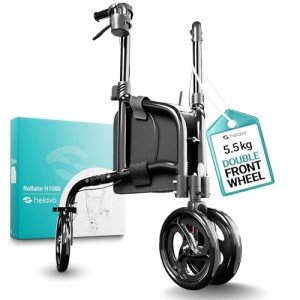
Ergonomic Rollator
Add a review FollowOverview
-
Founded Date May 29, 1944
-
Sectors Medical Coding
-
Posted Jobs 0
-
Viewed 23
Company Description
The Complete Guide To Rollator Walker
Rollator Walker Safety: A Comprehensive Guide
As people age or face mobility challenges due to disease or injury, keeping independence frequently ends up being a priority. Rollator walkers, providing both support and mobility, have ended up being indispensable tools for numerous. Nevertheless, while they use various benefits, guaranteeing safety while utilizing a rollator walker is critical. This article supplies thorough insights into Rollator Walker Safety [Okoskalyha.hu], including best practices, common hazards, and essential ideas for users and caregivers.
Comprehending Rollators
A rollator walker is a mobility device with wheels that enables people to stroll with the support of a frame. Unlike standard walkers, rollators typically feature:

- Three or 4 wheels for simpler maneuverability
- Hand brakes for stopping and managing speed
- A seat for resting when required
- Storage compartments for bring individual items
These functions make rollators ideal for both indoor and outdoor use, boosting the lifestyle for users by offering a sense of self-reliance.
Benefits of Using Rollator Walkers
- Increased Mobility: Rollators can assist users in moving safely and conveniently.
- Assistance and Stability: With a sturdy frame and brakes, they offer vital support when standing or walking.
- Comfort: Many rollators included padded seats, allowing users to rest as required.
- Convenience: Integrated storage solutions can carry necessary products, freeing hands for better balance.
Typical Hazards Associated with Rollator Walkers
While rollators can improve mobility and safety, they can also pose threats. Users should understand prospective dangers to reduce accidents:
- Uneven Surfaces: Rollators may tip over if utilized on irregular or sloped terrain.
- Braking Issues: Failing to engage the brakes sufficiently can cause falls.
- Excess Weight: Overloading the storage compartments can affect stability.
- Inappropriate Use: Not making use of the rollator as meant can lead to mishaps.
- Poor Maintenance: Neglecting routine examine wheels and brakes could cause failure during use.
Rollator Walker Safety Tips
To improve safety while using rollator walkers, think about the following tips:
1. Appropriate Fit and Adjustment
- Height Adjustment: Ensure that the handle height is set to the user’s wrist level when standing upright. A correct fit motivates much better posture and control.
- Seat Height: If the rollator has a seat, ensure it’s comfy and available for resting.
2. Regular Maintenance
- Examine Brakes: Make sure hand brakes are working properly. Adjust or change them if necessary.
- Check Wheels: Regularly inspect wheels for wear and tear, and ensure they spin easily.
- Analyze Frame: Check for loose screws or fractures in the frame to guarantee it stays sturdy.
| Upkeep Task | Frequency |
|---|---|
| Brake inspect | Weekly |
| Wheel evaluation | Monthly |
| Frame examination | Regular monthly |
3. Environment Awareness
- Clear Pathways: Keep living spaces complimentary from clutter and challenges that may posture a tripping danger.
- Lighting: Ensure that areas are well-lit to avoid mistakes, especially during night hours.
- Avoid Slippery Floors: Be careful on damp or waxed floorings, as they can result in falls.
4. Safe Walking Techniques
- Engage Brakes When Stopping: Always engage brakes before sitting or while resting.
- Use Proper Walking Technique: Move gradually and maintain a consistent pace, taking actions that match the rollator’s width.
- Balance While Turning: Turn thoroughly, using the rollator for support as required.
5. Look for Assistance
- Involve Caregivers: Encourage member of the family or caregivers to help in browsing tough terrains or circumstances.
- Benefit From Community Resources: Many communities offer mobility training for those utilizing walk-assisting devices.
Frequently Asked Questions about Rollator Walker Safety
Q1: How do I pick the right rollator walker?
When choosing a rollator, consider the user’s weight, height, and planned use. It’s also necessary to check for features such as hand brake effectiveness and wheel size, which can affect maneuverability.
Q2: Can I use a rollator walker on uneven surface areas?
While rollators can deal with a variety of surfaces, it is best to avoid steep inclines, gravel, or cobblestones, as these can be dangerous. Stay with flat, smooth surfaces whenever possible.
Q3: How can I avoid falls while using a rollator?
Engaging the brakes when sitting, keeping pathways clear, changing your rollator for the correct height, and bearing in mind your environments can greatly decrease the threat of falls.
Q4: Are all rollator walkers the exact same?
No, rollators can be found in different types and sizes, designed for various needs. Some may have additional devices like baskets, while others are lightweight or function a greater weight capability.
Q5: Is it safe to carry bags on a rollator?
Constantly be conscious of the weight limit and distribution of the load. Use the rollator’s designated storage solutions and avoid overloading it.
Rollator walkers are important gadgets that boost mobility and promote independence for users dealing with mobility obstacles. Nevertheless, guaranteeing safety while utilizing these devices is crucial. By comprehending prospective risks, adhering to safe practices, and maintaining the walker routinely, users can enjoy the benefits of their rollator with minimized threat. Eventually, the objective is to assist in confidence and stability, allowing individuals to navigate their world with security and ease. As care providers, household members, and neighborhoods focus on safety, they empower users towards a much better, more independent quality of life.

